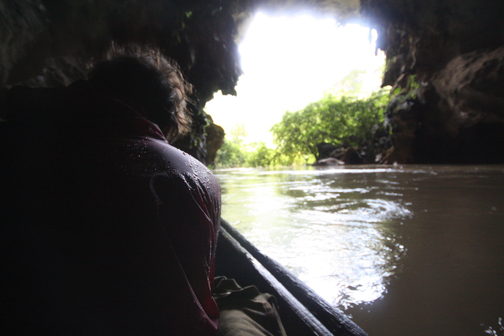Sam Brewster has set out on a globe-trotting journey this summer, visiting exotic destinations throughout Asia. He files this fourth travel log from Laos.

Well, here we are. Laos. The most rural and most beautiful of all of the countries that we have visited so far.
Cambodia wasn’t all that great; what it lacked in real culture it more than made up for in smell. Phnom Penh was the smelliest city I have ever been to, and I’ve been to Manchester. The city was bustling, with a great divide between the rich and poor. The wealthy coast about in giant SUVs, whilst the poor scurry about, collecting plastic bottles and carrying baskets full of (barely) living poultry to the bug-ridden market.
The one redeeming part of the experience, ironically, was the genocide museum at Tuol Sleng. It was a prison block used by the Khmer Rouge, and was converted from a school. The museum was surprisingly objective in the telling of the stories from the horrific period, and used the viewpoint of a Swedish journalist who visited Cambodia under the Khmer Rouge regime.
The world-famous temple complex of Angkor Wat was a great two day excursion. We used the pleasant, though touristy, Siem Reap as our base to visit the Angkor region. The best temples, however, were the ones that had become one with nature. Roots had grown over and around some of the temples, like some sort of viscous rain flowing in between the stones.
Built in the early 12th century, the complete temples are similar in age to Lincoln Cathedral, without the 15th Century turrets, giving the building of the temples some sort of relation to British history.
After a brief return to Phnom Penh to get visas for Laos, we left on a bus heading north to the border town of Stung Treng, on the Mekong river near Laos.
In southern Laos we spent a couple of days on the island of Don Det, in the Si Phan Don region. This was a welcome break from the sticky claustrophobia of Cambodian cities, and provided a great first taste of Laos and its scenery. We had a great electrical storm on the first night: blanket lightning that lit the horizon as if it were day; fork lightning emanating from and spreading between a cluster of clouds, creating a web of light. It was spectacular.
Using bikes to find the old French Colonial railway bridge that linked the tiny island to its neighbour, Don Khon, we headed south to find some powerful and violent rapids. Even though one of us contracted dengue fever in Cambodia and had to go directly to Vientiane, the Laotian capital, to seek medical treatment, Don Det provided a serene and much needed break from the barrage of busy cities, which are unfortunately necessary to get from place to place.
Our next stop was Thakhek, about halfway up the country on the Mekong River. This was our base from which we embarked on a three-day adventure on awful Chinese-made motorbikes. Their poor build and lack of power meant they were not at all suited to the task ahead.
Our goal was to reach the spectacular 7km long cave in the heart of ‘The Loop’. The Loop is a route around the heart of central Laos, often travelled by tourists on motorbikes in order to take in the rural life. The cave would take two days to reach by motorbike.
Over the course of three days we rode over 270km of questionable roads. On the second day the path took us over 80 km of trails suitable only for a 4×4, but we got to see some amazing scenery. Despite coming off on the slick, muddy track once along the way, the whole journey was an experience no one should miss when visiting Laos.
After our rural excursion the sleepy, yet European flavours of Vientiane offered a pleasant level of comfort to recuperate before visiting the town of Vang Viang, which is notorious for catering to drunken western tourists and is a haven for hedonists. In Vientiane bakeries and quiet riverside cafes were plentiful, the atmosphere was anything but electric, but the comfortable Mediterranean feel of the place was just perfect to re-supply and recover to some sort of civilised human state, fit to re-enter the Western civilisation that awaited us in Vang Viang.
We arrived in Vang Viang at about midday in a bus full of sunburned Malaga-package-holiday-ites, and rejoined our our dengue fever friend and his manservant. Here we indulged in a spot of tubing down the Mekong in an old tractor tyre inner tube, probably the only thing to do in Vang Viang besides visit a couple of caves. Although the trapeze swings and slides into the river successfully regressed our party to a bunch of giggling primary school kids with a giant playground at our disposal, I don’t think I could spend more than a day taking part in the activities.
Tubing is purely British, with bars built on the riverbanks pumping out Lady Gaga and whatever other soulless filler that has been spewing out of the UK music scene recently, titillating the bikini-clad, drunken holidaymakers over on a weekend trip from Bangkok. Once under the influence of the free whiskey and buckets of cocktails it’s great fun for the moment, but it’s not something that will put you at awe. You’d still find more culture in a pint of Carling.
Vang Viang has another, slightly less appreciated attraction; it is surrounded by karst limestone outcrops, reminiscent of those around Mai Chau and Hai Long Bay, with crystal clear water springing from the caves. Despite the scenery, it is too late for Vang Viang to be anything other than what it is: a haven for those who are missing the mindless club scene from back home. As they say in the Lonely Planet guide, “You’ll love it and hate it.”
